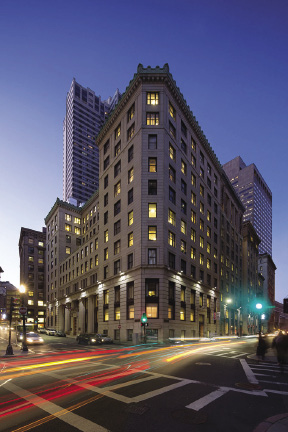Historically, the center of the City of Boston has not had a name. In the 1960s and 1970s, the Boston Redevelopment Authority (BRA) frequently used the term "Financial District."
The Financial District traditionally was at the corner of State and Congress Sts., caused by the presence of such bank buildings as Merchants National Bank, The National Shawmut Bank and State Street Exchange. In one sharp, sudden move in the 1970s, the Financial District took a 90° turn and "marched" down Congress Street to the Fort Point Channel.
The BRA also used the term "Retail District," referring to the corner of Washington and Summer Sts. Department stores, including Gilchrist Co., Filenes and Jordan Marsh Co., were the key properties anchoring three of the four corners. Other than North and South Station, there were no other anchor points in the city. The overall result was that come 6:00 pm in the evening, activity ceased on Boston's streets and the center of the city "rolled up its sidewalks."
Back on July 9, 2012, the Banker & Tradesman front-page article was titled: "Fading Into Obscurity: Neglected, Old Fashioned And Increasingly Dull, What Will Become Of Boston's Financial District?"
The purpose of this article is to tell the story of what two short years to mid-2014 has created within the city, and to predict what will happen in the subsequent three years, bringing us into 2017.
The Great Recovery - 2012-2014
What is Known: Millennium Tower, a 60-story 1.4 million s/f building and the tallest within Boston's center city, broke ground in 2013 and will add approximately 450 luxury residences plus office, retail and parking. As noted in a recent article by The Wall Street Journal, "The new wave of development is transforming the landscape of Downtown Crossing. The neighborhood's population increased 44% from 2000 to 2010, compared with a 4.8% rise in Boston's total population." The "march" in the second decade of 2000 is down Washington St. and encompasses over an additional 2,000 units at Millennium Place, The Kensington, 45 Stuart St., Parcel 24, The Ink Block and 275 Albany St. The southern border of Stuart St. has been breached.
What is Not as Well-Known: The December 2013 sale of The National Shawmut Bank building and its pending impact on the city have been understated. "The Block" as it was named, formerly Fidelity's headquarters, is a boutique Class B building that is expected to hatch multi-level retail, multi-story housing and a variety of users to service Boston's "New Downtown."
2014-2017 - The "New Downtown"
With Boston being a world-class city, "cities within cities" have been created; East Cambridge and the Seaport are prime examples. In turn, Class A office building rents have exploded!
"Innovation" tenants have been priced out of these four markets. The one place where they can go is into "Downtown," where Class B and C and low-rise rents are 30-40% below these locations.
The "New Downtown" type of tenant is that which has not been seen there before. They are the tech and communication tenants and start-up tenants attracted by restaurants, stores, people and transportation. These tenants wish to "cluster" close to business partners and communication firms.
Where State St., Goodwin Procter and PwC "exited" what was called the Financial District, other tenants who have entered are the "B Cool" types. Examples include Rapid 7, who moved its headquarters from Back Bay to Summer St.; PayPal, who consolidated from other parts of the city to One International Place; Isobar, a digital advertising and communications firm that relocated from the suburbs; and many more.
The reason for such moves is a compact city center, public transportation and a lot of like-minded working professionals. Important to note is that the Cambridge Innovation Center, situated at One Broadway in Cambridge for the past 15 years, has signed a lease at 50 Milk St. with enough space to start 300 new businesses.
Conclusion
It needs to be said that Boston is one of the world's great growth engines. For years I have followed New England Economic Partnership forecasts. My read of their projections is that Boston could have an unemployment rate as low as 4.8% by 2017. The age of employees would be expected to drop and be housed within the reinvigorated "New Downtown." The "New Downtown" is expected to be far broader in base. When the area consisted of financial and retail districts, rents dropped sharply outside of these districts. Chauncy St. and Tremont St. were the wasteland in terms of rent. Their buildings, mostly Class B to C in character, took the longest to lease and were at rents at the lower market end.
The recreation of the CBD as a "New Downtown" will make the center of the city another "city within a city," just as is happening within East Cambridge and the Seaport.
Webster Collins, MAI, CRE, FRICS is an executive vice president within CBRE's Valuation and Advisory Group, Boston. Trevor Regensburg, a research analyst, assisted in the preparation of this article.










